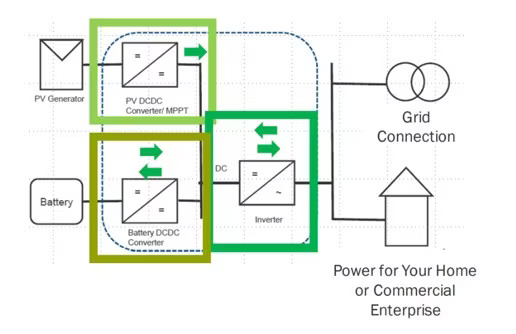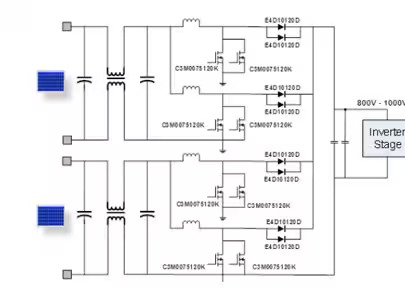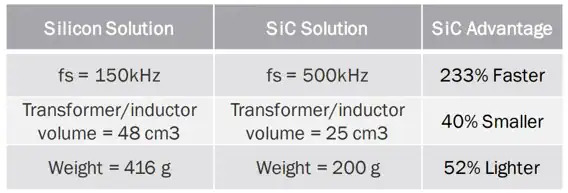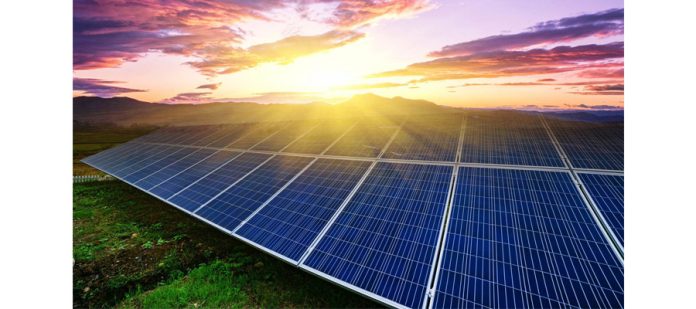Courtesy : Arrow
Silicon carbide (SiC) technology has more advantages than traditional silicon (Si), insulated-gate bipolar transistor (IGBTs), and other technologies, including higher switching frequencies, lower operating temperatures, higher current and voltage capacities, and lower losses, which lead to increased power density, reliability, and efficiency. This article will introduce the development trend of SiC and its application in energy storage systems (ESS), as well as the SiC power solutions launched by Wolfspeed.
SiC technology that greatly reduces the cost of energy storage applications and improves efficiency
SiC has become a mature technology that is transforming the power industry in many applications across the industrial, energy, and automotive segments, ranging from watts up to megawatts. Since SiC devices operate at cooler temperatures and result in smaller magnetics, thermal management and power components are now becoming smaller, lighter, and cheaper, thereby lowering total BOM costs while also enabling smaller footprints.
With the rapid development of SiC technology, SiC solutions have also been widely adopted in power delivery systems, particularly in Energy Storage Systems (ESS) applications, such as electric vehicle charging systems and solar systems with battery energy storage. DC/DC boost converters, bidirectional inverters (for AC/DC and DC/AC conversion), and battery charging circuits in these systems can all benefit from SiC technology, resulting in a 3% increase in system efficiency, a 50% increase in power density, and a reduction in size and cost of passive components.
A typical ESS architecture with a power source (photovoltaic), a DC/DC converter, a battery charger, and an inverter for delivering energy to the home or back to the grid. SiC technology is adopted in all three power blocks, resulting in improved efficiency, size, weight, and cost.
For example, in the conversion of collected energy in an ESS for storage or delivery to homes/buildings, a DC/DC boost converter for solar photovoltaic applications is typically used. SiC technology offers higher system efficiency and power density compared to traditional silicon technology, resulting in a 70% reduction in system size, over 60% reduction in energy consumption, and a 30% reduction in system cost, making SiC technology the optimal choice for ESS applications.

SiC solutions with higher power density and system efficiency
Wolfspeed has launched a variety of SiC solutions for ESS applications, such as Schottky diodes/MOSFETs (with current ratings of up to 100 A for packaging and 196 A for bare-die packaging) and power modules, as seen in the WolfPACK family of devices, whichhave a current rating of up to 450 A. These products can be used in single-phase residential systems (5–15 kW) or three-phase commercial systems (30–100 kW). The architecture and power circuit topologies will be similar; however, they can be scaled depending on the power level.
Taking the Wolfspeed CRD-60DD12N reference design as an example, it is a 60 kW SiC-based interleaved boost converter containing several SiC MOSFETs and diodes. The architecture adopts four interleaved channels, which help scale the output power up to 60 kW while maintaining an efficiency of 99.5% with 850 VDC output. This design includes two C3M0075120K MOSFETs (in a TO-247-4L package with a Kelvin source pin), two C4D10120D diodes per channel, and a CGD15SGOOD2 isolated discrete gate driver.
In the CRD-60DD12N reference design, if a BOM cost analysis/comparison is performed at different switching frequencies, significant cost savings could be realized at higher frequencies (100 kHz versus 60 kHz) due to the use of smaller, lighter-weight components/magnetics, despite the potential increase in cooling costs due to higher operating temperatures. However, in general, higher frequencies result in higher power density, higher system efficiency, and lower overall costs. Therefore, SiC technology has the potential to provide better performance at a lower price point.

Reference designs supporting advanced digital control schemes
For simple two-level inverter/active front end (AFE) designs with SiC MOSFETs, Wolfspeed’s reference designs highlights SiC advantages for both the inverter and DC/DC charging circuitry, which can operate in single- or three-phase mode, b achieving peak efficiencies of greater than 98.5% for both charging and discharging. The converter section of this reference design consists of a simple, two-level AC/DC converter that is compatible with both single- and three-phase connections, using only six SiC MOSFETs. While this configuration may not be as low-cost as most IGBT converters, it outperforms in terms of efficiency and loss. On the other hand, the T-type AC/DC converter may offer similar switching frequency and efficiencies, but it often involves complex control, higher part counts, and lower power density.
In this reference design, the DC-link voltage can be up to 900 V, while the battery voltage typically remains around 800 V. Due to the electrical and thermal stress, the C3M0032120K 1200V 32-mΩ SiC MOSFET from Wolfspeed is well-suited for this application, based on its figure of merit, easy control and Vgs drive characteristics, and Kelvin source package, which reduces switching losses and crosstalk.
This topology enables advanced digital control schemes that serve different functions, such as a single-phase interleaved PFC scheme or a three-phase DQ transformation space-vector PWM scheme that balances switching losses in all devices, making it a highly flexible reference platform. Utilizing PWM control per switch can aid in sensing and balancing power dissipation while optimizing thermal performance, efficiency, and reliability. Efficiency testing and measuring across a variety of loads and voltage ranges for single-phase charging revealed that SiC achieves up to 98.5% efficiency, while IGBTs might reach 96%, resulting in approximately 38% lower losses for SiC. Similar peak efficiencies were achieved for three-phase charging, along with thermal performance operating well within the system and device limitations.
Overall, under the 22-kW inverter/AFE configuration, the utilization of C3M0032120K SiC MOSFETs and the flexible control scheme enable high efficiency (>98.5%), high power density (4.6 W/L), lower loss (60%), and bidirectional charger capability. This configuration can support the DC-link from both three-phase and single-phase AC inputs while outputting a wide battery voltage range of 200–800 VDC.

Lower cost and more controllable isolated DC/DC converter design
When designing an isolated DC/DC converter, the most commonly used solutions are half-bridge and full-bridge LLC converters. The CRD-22DD12N reference design by Wolfspeed is a 22-kW solution that can be configured as either a cascade converter or a single two-level converter. The cascade converter can either utilize 650-V Si MOSFETs or SiC components, but Si MOSFETs generally have higher part count, higher conduction losses, higher control complexity, and higher system cost. The single two-level converter uses SiC components for the higher voltage (1,200 V) and switches at a much higher frequency of 200 kHz. Main advantage of using SiC components here is higher efficiency/lower losses, along with some additional features, such as zero-voltage turn-on, low-current turn-off, and lower risk for EMI. The topology of the single two-level converter has a lower part count compared to the cascade converter, which helps to reduce system cost and simplify control.

When considering power components for this 22kW design, Wolfspeed’s C3M0032120K 1,200-V 32-mΩ MOSFET provides the best electrical stress and thermal characteristics to suit the converter. In addition, its Vgs can support 15 V, making it easy to drive. A variable DC-link voltage control (based on sensed battery voltage) enables the best system efficiency and ensures that the CLLC runs close to resonant frequency. When the battery voltage is low, the control switches to phase-shift mode, which reduces gain without operation inefficiently outside of the resonant frequency range.
In this way, it means that similar high efficiency can be achieved at lower output voltages using the same hardware. If lower battery voltage is needed, the CLLC primary can be operated as a half-bridge, which further reduces gain but maintains the efficiency zone. This lower efficiency can still be acceptable due to the lower operating cost and less stringent thermal design.
The converter’s efficiency results are similar to the inverter reference design, with peak efficiency of 98.5% across most of the load range. The variable DC-link voltages and resultant efficiency remain above 97% until the design enters half-bridge mode, which limits efficiency and power delivery capabilities during charging. In general, the use of SiC MOSFETs along with the flexible control scheme enables high-efficiency (>98.5% efficiency for charging/discharging) and high-power density (8 kW/L) bidirectional chargers that support both single-phase and three-phase AC inputs. When compared with Si, higher efficiency and power density can be achieved at significantly lower cost due to the simplicity of the gate drive, which allows for fewer thermal management components, reduced part counts, and smaller magnetics.

Summary
The industry application has greatly benefited from SiC components, primarily due to their thermal properties and faster switching with lower losses. The SiC MOSFETs exhibit lower conduction losses at higher temperatures due to less temperature dependence of the turn-on resistance, enabling high-frequency switching. In addition, the high-performance body diode allows for high reliability in resonant converter applications, while a smaller output capacitance makes it easier to achieve zero-voltage switching in LLC converters.
On the other hand, SiC’s typical size/weight benefits over Si components (rated for 650 V). Usually, silicon components require a transformer plus the resonant inductor, whereas SiC configurations can eliminate the need for a separate transformer/inductor, saving on weight and space.
Wolfspeed’s SiC device series is capable of adapting to all power ranges of applications, ranging from 1 kW up to megawatts, including high-power modules. Wolfspeed offers a range of solutions, Designer can choose from various topologies and sourcing options while optimizing BOM costs and physical size/layout.
Wolfspeed also provides reference designs and evaluation toolkits for various topologies, such as AC/DC power-factor correction, buck/boost DC/DC, high-frequency DC/DC, and bidirectional AC/DC, DC/DC, and DC/AC kits. Additionally, the SpeedFit design simulator helps to characterize system-level circuits, model common topologies, and select the right SiC device for your application.
Whether using discrete solutions or high-power modules, SiC has shown tremendous opportunities in energy storage applications, from residential to industrial, and Wolfspeed’s portfolio/resources enable the most flexible, scalable, high-performance designs at a low cost and small footprint. It will be one of your best choices when developing power applications.








